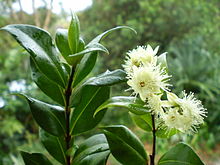- Backhousia myrtifolia
-
Cinnamon myrtle 
Backhousia myrtifolia, leaf and flower Scientific classification Kingdom: Plantae (unranked): Angiosperms (unranked): Eudicots (unranked): Rosids Order: Myrtales Family: Myrtaceae Genus: Backhousia Species: B. myrtifolia Binomial name Backhousia myrtifolia
Hook. & Harv.Synonyms[1] - Backhousia australis G.Benn. nom. inval.
- Backhousia riparia Hook. & Harv.
Backhousia myrtifolia is a small rainforest tree species grows in subtropical rainforests of Eastern Australia. B. myrtifolia is also known as carrol, carrol ironwood, neverbreak, ironwood or grey myrtle, or Australian lancewood. Cinnamon myrtle is a spice form of B. myrtifolia.
Backhousia myrtifolia can grow up to 30 metres. The leaves are ovate or elliptic, 4-7 cm long, with a cinnamon-like odour. Flowers are star-shaped and borne in panicles. The small papery fruit are bell-shaped.
Essential oil
The name 'cinnamon myrtle' was originally coined in the late 1980s to describe a specific elemicin variant used as a flavouring spice. However, the name 'cinnamon myrtle' is now used to describe the species in general.
Cinnamon myrtle is part of a group of related Myrtaceae family members that were popularized as spices in Australian bushfood cuisine in the late 1980s and early 1990s. This group of plants also includes lemon myrtle (Backhousia citriodora) and aniseed myrtle (Syzygium anisatum).
External links
- Plant profile, including cultivation requirements [1]
References
- Floyd, A.G., Rainforest Trees of Mainland South-eastern Australia, ISBN 0-909605-57-2.
- APNI Australian Plant Name Index
Categories:- Bushfood
- Myrtales of Australia
- Myrtaceae
- Australian cuisine
- Crops originating from Australia
- Flora of Queensland
- Flora of New South Wales
- Myrtaceae stubs
- Australian rosid stubs
Wikimedia Foundation. 2010.
